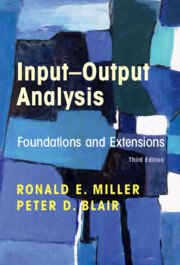Book contents
- Input–Output Analysis
- Input–Output Analysis
- Copyright page
- Contents
- Figures
- Tables
- Preface
- 1 Introduction and Overview
- 2 Foundations of Input–Output Analysis
- 3 Input–Output Models at the Regional Level
- 4 Organization of Basic Data for Input–Output Models
- 5 The Commodity-by-Industry Approach in Input–Output Models
- 6 Multipliers in the Input–Output Model
- 7 Supply-Side Models, Linkages, and Important Coefficients
- 8 Decomposition Approaches
- 9 Nonsurvey and Partial-Survey Methods:
- 10 Nonsurvey and Partial-Survey Methods:
- 11 Social Accounting Matrices
- 12 Energy Input–Output Analysis
- 13 Environmental Input–Output Analysis
- 14 Mixed and Dynamic Models
- 15 Additional Topics
- Postscript
- Book part
- Author Index
- Subject Index
- References
5 - The Commodity-by-Industry Approach in Input–Output Models
Published online by Cambridge University Press: 06 January 2022
- Input–Output Analysis
- Input–Output Analysis
- Copyright page
- Contents
- Figures
- Tables
- Preface
- 1 Introduction and Overview
- 2 Foundations of Input–Output Analysis
- 3 Input–Output Models at the Regional Level
- 4 Organization of Basic Data for Input–Output Models
- 5 The Commodity-by-Industry Approach in Input–Output Models
- 6 Multipliers in the Input–Output Model
- 7 Supply-Side Models, Linkages, and Important Coefficients
- 8 Decomposition Approaches
- 9 Nonsurvey and Partial-Survey Methods:
- 10 Nonsurvey and Partial-Survey Methods:
- 11 Social Accounting Matrices
- 12 Energy Input–Output Analysis
- 13 Environmental Input–Output Analysis
- 14 Mixed and Dynamic Models
- 15 Additional Topics
- Postscript
- Book part
- Author Index
- Subject Index
- References
Summary
Chapter 5 explores variations to the commodity-by-industry input–output framework introduced in Chapter 4, expanding the basic input–output framework to include distinguishing between commodities and industries, i.e., the supply of specific commodities in the economy and the use of those commodities by collections of businesses defined as industries. The chapter introduces the fundamental commodity-by-industry accounting relationships and how they relate to the basic input–output framework. Alternative assumptions are defined for handling the common accounting issue of secondary production, and economic interpretations of those alternative assumptions are presented. The formulations of commodity-driven and industry-driven models are also presented along with illustrations of variants on combining alternative assumptions for secondary production. Finally, the chapter illustrates the problem encountered with commodity-by-industry models, such as non-square commodity–industry systems, mixed technology options, or the interpretation of negative elements.
Keywords
- Type
- Chapter
- Information
- Input-Output AnalysisFoundations and Extensions, pp. 176 - 237Publisher: Cambridge University PressPrint publication year: 2022



